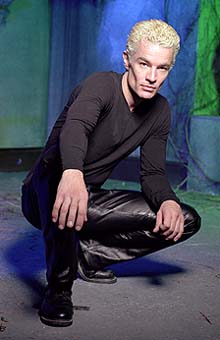
|
Media Matters
And then came the slap. First, an unconscionably evil nerd who meant to murder Buffy shot and killed Tara instead. Willow, propelled by blood-red rage and vengeance, then tortured and killed the nerd before moving on to a demonic plot to destroy the entire world. So much for sensitivity.
The recent Buffy segments followed a disturbingly similar course. Not only did they come complete with the two-for-one lesbian cliché package of one dead lesbian and one evil lesbian, but the setting and events leading up to Tara's death also fell into line with the storied lesbian cliché. One of the most overused features of the concept has been that the death is generally directly connected with the act of lesbian sex, usually occurring soon after a couple has made love. Tara died at the end of an episode that included her and Willow having sex-indeed, she took her last breath beside the very bed in which the two young women had slept together only minutes before. Likewise, consistent with many past examples, Tara's death was a horribly violent one. A bullet ripped through her chest, showering Willow with her lover's blood. For me, though, what is the most distressing about the recent Buffy example of the "dead/evil lesbian cliché" is that I really thought the program was committed to providing an accurate depiction of lesbian characters that young people could identify with. So did others. Back in 2000, the Gay and Lesbian Alliance Against Defamation commended the program. GLAAD even went so far as to urge viewers to contact Joss Whedon, the producer behind the storyline, and thank him. The aspect of the Willow and Tara characters during the last couple years that I particularly liked was that they were neither idealized nor irreconcilably flawed. When Tara was introduced, she was painfully shy, inarticulate, self-conscious and no Jennifer Aniston in the looks department-just like real-life teenagers. Willow had her faults, too; her dependence on magic became such a problem, in fact, that it drove Tara to break up with her. And so, likewise, the young women's relationship was less than perfect. After Tara moved out of the home that she and Willow had shared, both characters struggled to regain their emotional balance. Only after several months had passed and Willow had confronted her addiction-in this instance, magic, but it could just as easily have been drugs or alcohol-did the two characters arrange a coffee date and then a reconciliation. The message: Gay life-like life in general-is not always easy. But, with perseverance and commitment to growth, gay life-again, like life in general-most certainly can be rich and fulfilling. As a college professor who sees dozens of young people struggling with their sexual identity every year, I was very pleased that I could finally recommend Buffy as a television program that provided a picture of young gay life that was both realistic and positive. I no longer can.  Rodger Streitmatter, Ph.D. is a member of the School of Communication faculty at American University in Washington, D.C. His latest book, Voices of Revolution: The Dissident Press in America has just been published by Columbia University Press. He is also the author of Unspeakable: The Rise of the Gay & Lesbian Press in America (Faber & Faber, 1995) and Raising Her Voice: African American Women Journalists Who Changed History (The University Press of Kentucky, 1994)
Rodger Streitmatter, Ph.D. is a member of the School of Communication faculty at American University in Washington, D.C. His latest book, Voices of Revolution: The Dissident Press in America has just been published by Columbia University Press. He is also the author of Unspeakable: The Rise of the Gay & Lesbian Press in America (Faber & Faber, 1995) and Raising Her Voice: African American Women Journalists Who Changed History (The University Press of Kentucky, 1994)
|
|
© 1997-2002 BEI
The sexual orientation of individuals pictured in and writers for
Gay Today should not be assumed.
 Buffy brings us back to reality
Buffy brings us back to reality  Bloody from Buffy the Vampire Slayer
Bloody from Buffy the Vampire Slayer